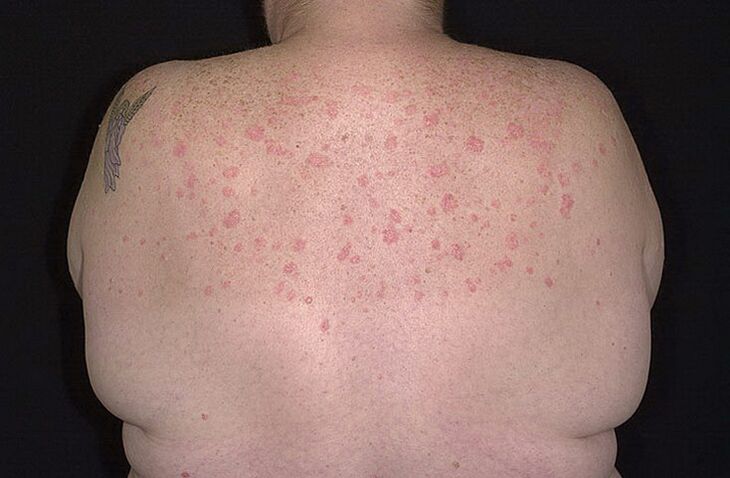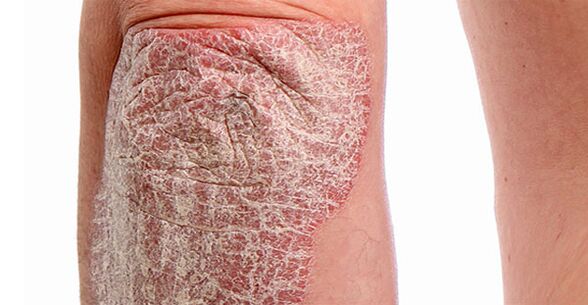The prevalence of skin diseases among the population of the planet is quite large.One of the most common chronic disorders of the skin is called psoriasis, on average of 2 to 5%(in other studies, from 3 to 7%) the world population suffers from this type of dermatosis.Therefore, it is important to understand if psoriasis is transmitted from person to person, which is more predisposed to this skin disorder, how to avoid complications, there are effective ways to treat popular medications and remedies.

What is it?
Systemic skin disease, characterized by the appearance of pathological processes, with the exception of the skin, also on the nails, a series of internal organs, joints, one of the many definitions of psoriasis.This dermatological violation significantly reduces the qualitative health level of the patient, with a pernicious effect on metabolism (a process associated with metabolism) in the body, improves the symptoms of cardiovascular disease and contributes to depressive conditions.Knowing its common name: squamous lichens, it is easy to guess how psoriasis looks: rashes in the form of papules (formation with a soft and bright surface, the shape resembles the hemisphere, color - pink), at an early stage as a small, with a pin head.After a while (several days), the pales are covered with scales that are easily eliminated, have a silver white tone.The type of skin of the patient with psoriasis in loved ones and others arouse interest, is it contrast or not psoriasis?According to dermatologists, there is no danger of infecting others.The carrier of the disease, any microorganisms is absent.The skin is affected here (the upper layers die): This is how the body reacts to external stimuli, to physiological dysfunctions during metabolism.

MKB-10 code
A detailed description of all types of psoriasis varieties, its characteristics are given in the International Classification of Diseases-Icd 10 (tenth review version).Orlinating a dermatological disease is reduced to the release of such types:
- Simple (vulgar or bad).It is considered one of the most common among all the prevalence of psoriasis is close to 80-90%.We recognize by its manifestations: a layer of white (gray) or white scales is formed in a healthy skin, which are thickened and inflamed areas of the skin, which are easily dried and exfoliated.The areas of the skin under such layers are very sensitive to injuries, subject to bleeding (they contain many smaller vessels), so they are called psoriatic plaques.Increasing in size, the plates can merge with each other, becoming a single place: "Paraffin lake".These spots can spread throughout the body.There is a simple head psoriasis, even in the hairy part, along the edge where hair growth ends.After a while (several months) of the "lakes", they tend to disappear, leaving a bleached skin.MKB 10 - L40.0 code.
- Point (fallen in shape, detained).This type of psoriasis has a prevalence slightly lower than the vulgar.A sudden manifestation is inherent to him: in patients, multiple small and dry eruptions that stand out above the skin have a round configuration (or a form of fall), a lilac or reddish tone.Code - L4.
- PustuleniaIt bears his name due to the appearance of pustules (bubbles) that occur on the surface of the healthy skin and contain exudate (liquid, sterile in composition, is transicular).Code-l1-3, L40.82.
- Psoriasis of nail plates.The plates of arms and legs are subject to damage: they become brittle, they lose their natural color, thick and delxan.In addition, the result of the disease can be nail loss.The treatment is complicated due to the accumulation under the dead cell of the epidermis, dirt and dust.The careful, thorough and long -term care of nail plates is simply necessary.Code - L86.
- ArtropathicIt is the "initiator" of the emergence of the inflammation process in the joints, also in the connective tissues of the body.First, small joints are more susceptible to him: the fingertips or legs swell.The exacerbation occurs in the fresh (cold), raw weather.This psoriasis is loaded with a serious way of the disease and even the establishment of disability for the patient.Code - L5+.
- The opposite or psoriasis of flexion surfaces.Externally manifested in the form of smooth, without peeling (or is slightly) inflamed stains (with redness) of the skin.Location: in places of skin folds (in the area of the armpits, in the groin, in places of the internal surface of the thigh, etc.).Code-l83-4.
- Erythrodermic.This type of psoriasis is characterized by the inflammatory process of the skin of the entire body, its peeling.It is often a consequence of the aggravated form of vulgar psoriasis, or excessive psychological stress, transferred a cold.Sometimes it happens as a reaction to alcohol taken.Code - L85.
- Another psoriasis: This species includes all other atypical escape options.Code - L8.

Causes
The basis of psoriasis can be different factors within the framework of the theories of formation of this type of dermatosis.
- Genetics.It is not necessary to demonstrate whether psoriasis contrasts with a genetic predisposition.The genetic theory of psoriasis only speaks of a greater risk of manifestation of this dermatosis as a result of a hereditary factor in humans.
- Violation of the hormonal background in the body (endocrine theory).The restorative functions (regenerative) of the tissues (skin) are lost due to the inappropriate functioning of the endocrine system.
- The consequences of infections.During the treatment of infectious diseases, complications can begin, directly reflected in the skin (infectious theory): skin loss of the ability to function normally after exposure to microorganisms, fungi, etc.
- Metabolism violation (metabolic functions) of the body: skin disease begins with inappropriate work of the circulatory system, for example, lymphocytes are excessively concentrated in certain areas of the skin.This also includes diabetes mellitus: it is that metabolic processes are significantly distorted.(Exchange theory).
- Immunity.Inappropriate work of the immune system leads to the impossibility of an adequate reaction of the body to health threats.This also manifests through skin reactions.(Immune theory).
Several reasons can be associated with the characteristics of an individual's life:
- irrational diet;
- abuse of psychoactive substances (alcohol, nicotine, etc.);
- inadequate use of medicines;
- excessive mental stress, stress;
- A sudden change in climatic conditions.

Symptoms and stages
Psoriasis symptoms differ according to the stage of the disease itself.There are 4 stages of psoriasis.
Initial.
In the initial stage, in the hands, the stomach, the back or other parts, the individual psoriatic manifestations are notable: small papules, pink, with a bright and smooth surface.These are specific manifestations, over time there is an increase in their number and location sites.
Progressive.
At this stage, the skin's peeling is added to the symptoms, at the beginning in the central part of the papules, which gradually grow, forming a pink corolla.The shape of the areas damaged by the disease gradually acquires a different configuration (Kebner symptom).Itching is observed.The duration of the stage is approximately 2 weeks.
Stationary.
In terms of duration, it does not have a specific time of time, you can change to the next stage (4th, regression), or return to the previous one (3rd, progress).The new elements in the skin stop appearing, the growth of the existing plates slows down, stops at all.
Regressive.
The complete stage of the disease cycle: Pelado goes "to nothing", the plates become flat, lose their bulge.Objects, as a rule, do not atrophy and form scars.Although the areas subject to disease lose their pigment (bleach), after time passes.
In children
The appearance of the disease in children is observed in rare cases.But at the same time, the course of psoriasis proceeds in a complicated way: the skin cover is rapidly covered with bubbles, almost the entire surface of the skin is captured.Bubbles contain a liquid (first transparent, then cloudy), their tests show the presence of pathological cells.Therapeutic intervention must be emergency.

In adults
Symptoms and adult treatment are based on the characteristics of the disease course.Patients are fixed:
- the general state of the physical weakening of the body;
- a sensation of power and fatigue that do not pass by step;
- Depression and depressive experience.
A specific symptoms depends on the type of psoriasis and its skin location.For example, in the legs, the manifestation of psoriasis is observed more frequently on the knees, feet.With complications, the symptoms are improved with the edema of the limbs.
Treatment
The pharmacological treatment of psoriasis is based on several approaches, depending on the characteristics of the disease.The means are used to normalize immunity (immunosuppression method);Agents that regulate metabolism and reduce inflammatory manifestations (corticosteroids);It means that they reduce the dividing functions of the cells and avoid tumors (cytostatic).As a means of direct exposure to the affected areas, ointment of psoriasis in the skin is applicable.It is designed to deal with skin dryness and the effect of "hardening."A special place is occupied by non -hormonal ointments that affect inflammation spotlights, but do not lead to an increase in hormonal background.
Psoriasis ointments:
Non -hormonal influence:
- Zinc: is an antiseptic, a means to dry and eliminate the inflammation process;
- Salicil: It affects the best separation of the keratinized skin of the skin;
Hormonal exposure

The therapeutic effect occurs faster than ointment (all are intended to suppress itching, inflammation, allergies), but there are side effects.Patients are often offered ointment that eliminates psoriatic symptoms.An example is a debatable drug: one of its components is used during the day, the other at night.The ointment includes natural components (Licen, Earth fungus, Ruibarbo, Espino).Taking into account the treatment of hydrogen peroxide psoriasis, the reviews are distributed depending on the therapeutic effect obtained., In turn, it depends on the severity and type of skin violation itself.Apply peroxide in 2 options:
- externally (compresses, lotions of affected areas);
- Internally (a drop of peroxide is added to several tablespoons of water, drunk half an hour before meals; also digging a few drops in the nose).
The therapeutic effect of hydrogen peroxide is effective in the early stages of psoriasis and if the disease is not thrown.
Treatment of psoriasis with popular remedies at home

Several questions, how to cure psoriasis at home, if the result of the treatment will be kept in the case of public funds, is discussed by specialists and patients themselves.Psoriasis is called relapse disease that has a chronic shape.Therefore, it is important to regulate its course: the complete cure is very complicated.Of the popular remedies, the most effective are called:
- Tar (effective in the initial stages of dermatosis, relieve inflammation);
- Solidol (confronts psoriasis without difficulty, is effective for nails and the area of soles);
- Soda (affects the acidic environment, in particular, the skin, neutralizes the symptoms of psoriasis);
- Herbs (as a series of songs, reduces the level of inflammation of the psoriasis of the areas affected by psoriasis, improves the regeneration of the skin).
Be sure to track what type of nutrition you have.The diet must provide the balance of nutrients (carbohydrates, protein, fat) and not violate the metabolic characteristics of the patients.Natural allergens contained in food must be completely excluded.It is important to remember that the treatment of psoriasis should be complex.Its duration is determined both by the depth of damage to the body and by the stage of development.























